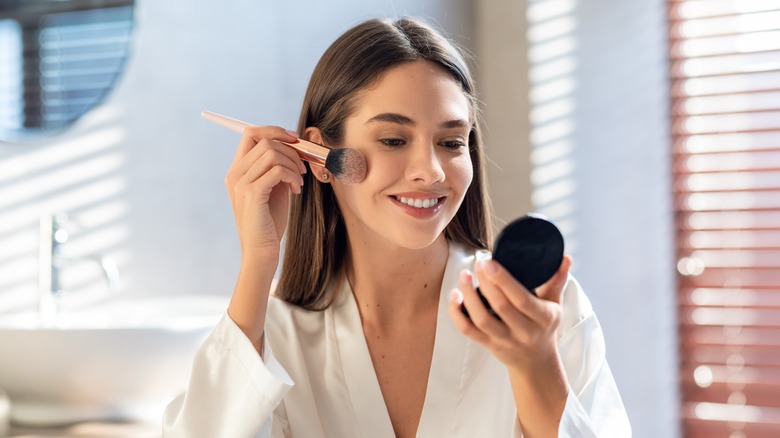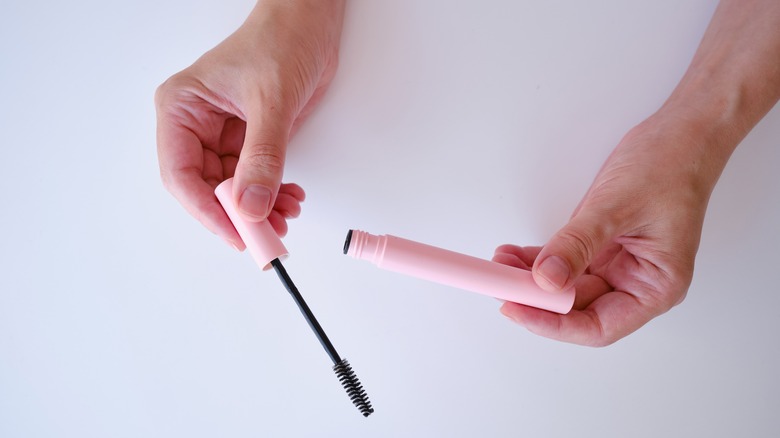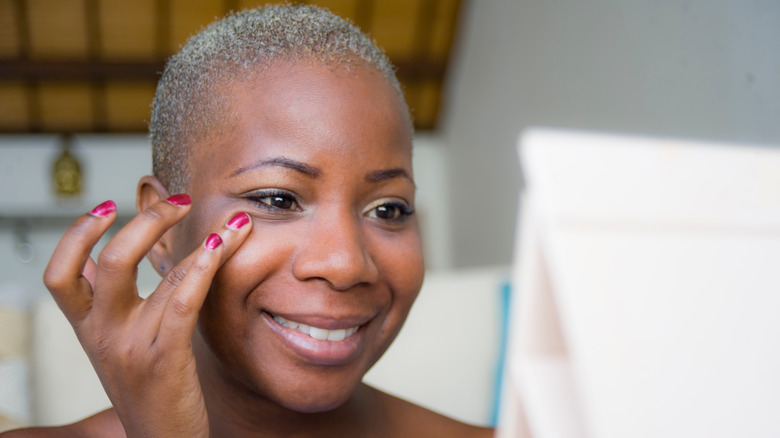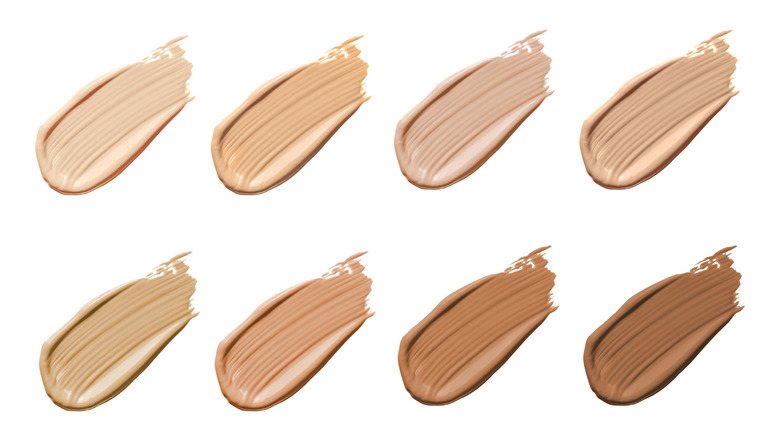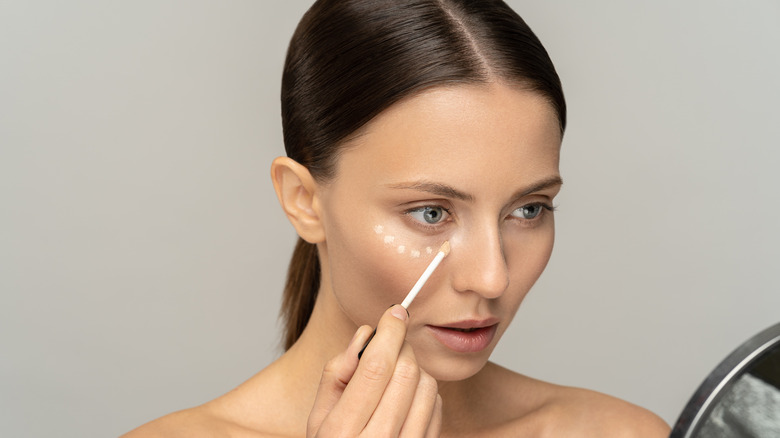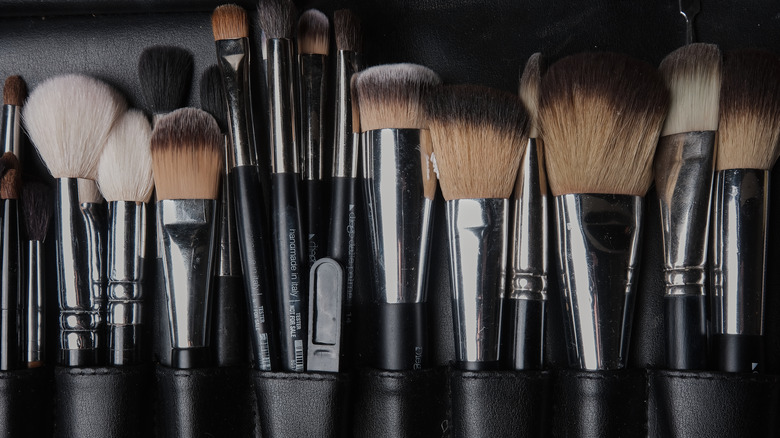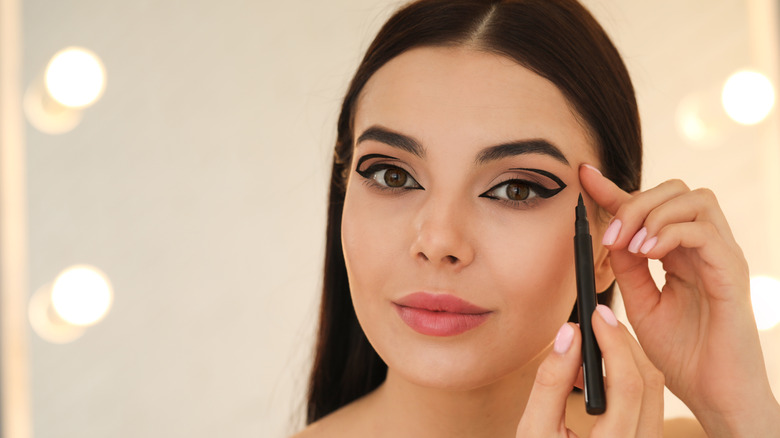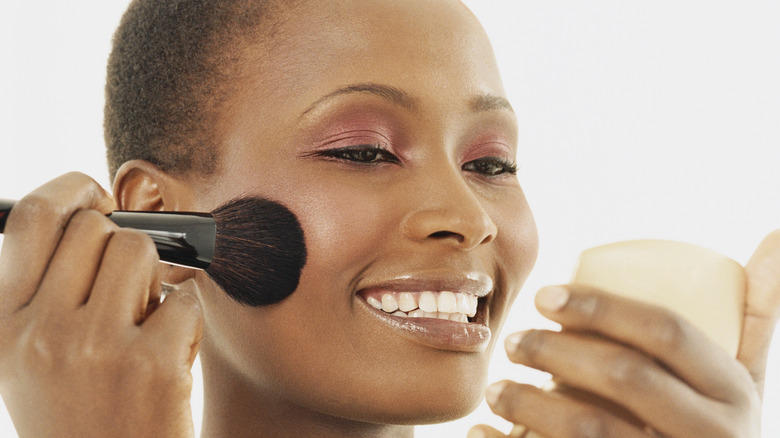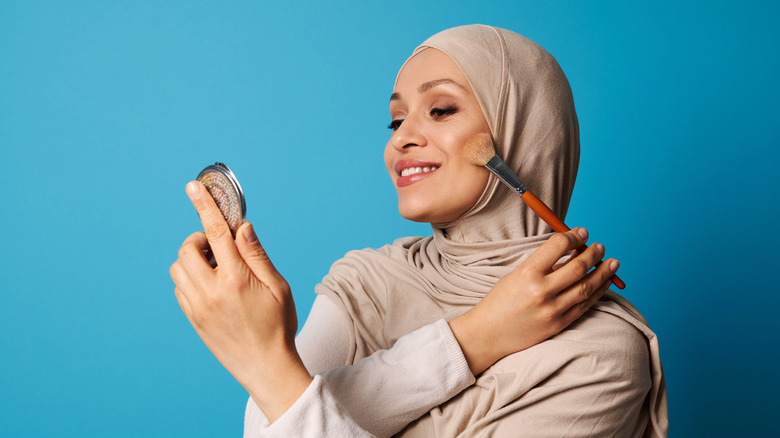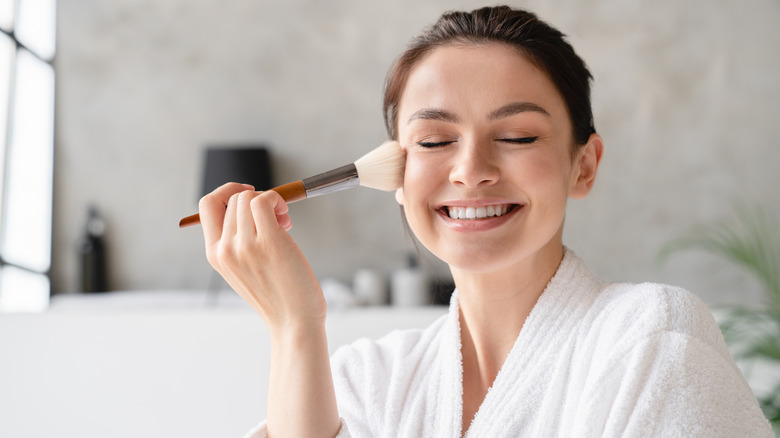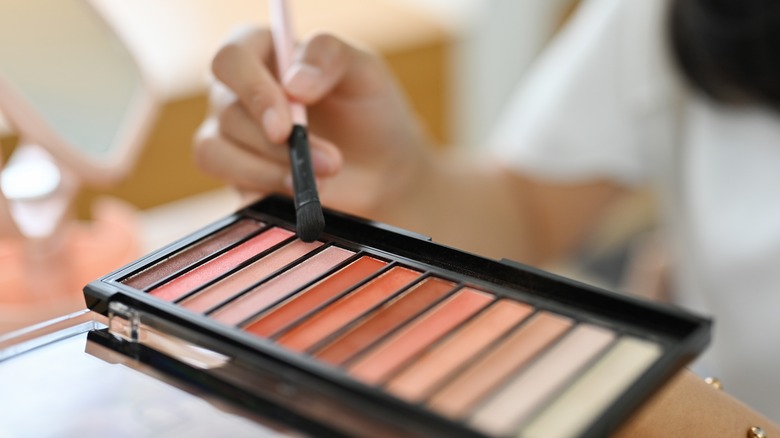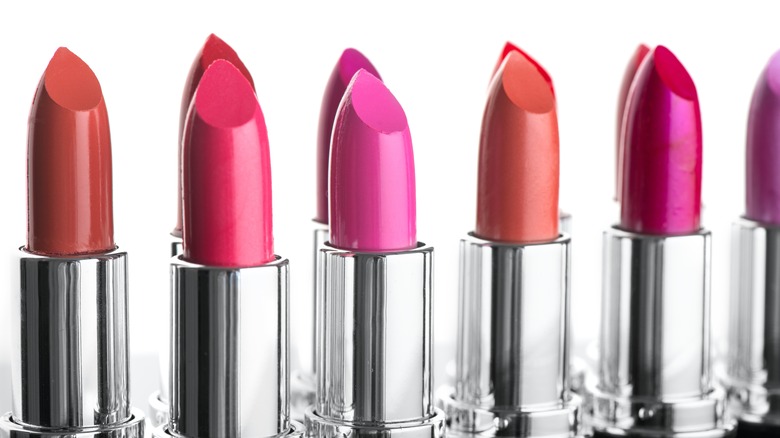When Should You Throw Out Makeup Products?
We'll be the first ones to admit that makeup costs are pretty wild, whether you stick to drugstore products or splurge at Sephora. Even a tube of mascara can set you back at least a couple hours of your work wages, and fun products like eyeshadow palettes and lipsticks add even more insult to injury. It's no wonder that many of us try to prolong the shelf life of our makeup products, doing everything we can — and using the products until they're dry, cracked, and running out — to keep them in our medicine cabinet, as replacing them can set us back triple digits. And while being thrifty and getting the most out of any product is typically a good thing, makeup products tend to get a little bit more complicated.
Given that makeup sits on your skin — and sometimes for hours upon hours — quality and care are important factors to consider. Like any medication or skin care product, makeup — foundation, mascara, or primer — has a shelf life, and it's important to keep an expiration date in mind. And while hitting Ulta Beauty might set you back a little bit financially, it's essential to know what products you can keep around for months at a time and which ones you should throw away (even if there's product left over).
Mascara
We're starting with a doozy — given that mascara is used so close to the eye, and bacteria can have a field day in that sensitive area of the face, you should be replacing your long lash enhancer once every couple of months. Saffron Hughes, a makeup artist in Great Britain, told Woman & Home that six months is the longest you can keep your mascara around, and it'd be best to replace it long before.
"Mascaras have a shelf life of up to six months, and if the formula starts to appear clumpy and there is an unpleasant smell, it should be disposed of sooner than six months," Hughes explained. The makeup artist's estimation was bolstered by Carly Cochrane, the beauty editor at Cosmetify, who assessed that replacing your mascara after just three months would be the most beneficial to your eye health.
"With continuous use of old products, this is a good opportunity for styes to develop," Cochrane explained, alluding to the always-uncomfortable experience that is having a stye. "The bacteria that can build up in your cosmetics can cause irritation and in severe cases, eye infections. Even allergies can develop from dirty cosmetics," she explained. So, even if there is product left over and you haven't gotten the full use of your wand, it's best to remain on the side of caution and toss that mascara tub about four times a year.
Primer
There was a time when we used dry beauty sponges, caked on as much foundation as possible, and didn't even know what primer was. Nowadays, we're pros regarding layering products, prepping the skin, and figuring out what primer works best. Primers come in all shapes and sizes. For some, using an oil-controlling primer is the most efficient way to keep their makeup looking shine-free throughout the day. For those of us with more noticeable pores, a putty primer can work wonders for maintaining a smooth complexion. Primers can be used to color correct, soothe the skin, and simply present a great base for foundation to sit on top — no matter your concern, having a primer in your medicine cabinet can improve your makeup.
Now when it comes to shelf life, primer is one of those products that you can keep around for a while. Erin Lindsay, the product development manager for ColourPop, told The Zoe Report that primer can last months, if not years, noting what people should look out for as their product ages.
"A good rule of thumb with all cosmetics is if the color changes, the formula begins to separate or the smell or texture changes, it's time to throw it away," Lindsay explained. "Once a product is opened, depending on the formula, shelf life varies. Primers (tube or pump) are good for about three years — because of air-tight packaging the product stays very clean."
Foundation
The foundation of any good face of makeup is just that — foundation. Whether you stick to powder coverage, cream, airbrush or prefer a combination entirely of your own creation, foundation can make or break a makeup look. Smoothing the complexion not only covers any blemishes or imperfections you wish to cover, but it provides the base for everything else — bronzer, blush, highlight — all these additional products need a healthy, balanced foundation underneath to stand out. But how long should you hold onto your foundation, and when is it time to toss it?
As noted by Elle, foundation should be replaced annually, but other indications may prove that time frame irrelevant. Foundation is regularly exposed to the oils from your skin, dirt, and dead skin cells — no matter how much you clean your makeup brushes and sponges (we'll get to that in a minute), the residue from your face will be picked up by the product. As such, pay attention to the texture, shade, consistency, and even the smell coming from your foundation, Elle details, and toss the product if any of these factors go awry. To prolong the life of your foundation, Elle suggests eliminating finger foundation application as much as possible — the combination is a recipe for bacteria. Ensure that any cap or container is screwed tight after use, and clean your makeup sponges and brushes to extend your foundation's shelf life.
Concealer
When faced with the desert island question — i.e., what is the one makeup product you would take with you to a desert island? — concealer might be our answer. While foundation and a good mascara are the finishing touches of any flawless makeup look, concealer has saved the day on plenty of occasions, as its universal use and ability to cover even the peskiest of blemishes is tried and true. Many of us have a preferred concealer — some like a pod version, others like an all-in-one applicator, and some even like the products that come with a sponge applicator right there on the stick. No matter your preference, concealers are game-changers. But when should you part with your beloved product and replace it? Health recommends that you shouldn't hold onto your concealer for any longer than a year (though given concealer's often daily use in the lives of many, it might not even last you that long).
There are other signs you should be aware of when it comes to your concealer's shelf life, even if the one-year expiration date has yet to expire. Health details that if you use a stick concealer, you should throw it out if the product starts to crack or changes in texture (watch out for a "tough" or "elastic-like" consistency). If you opt for a liquor concealer, pay attention to its ability to mix — if it "appears oily," "separates," or "smells rancid" (yuck!), throw it in the garbage.
Brushes and sponges
While foundation and mascara are often on our radars as highly used products that might need replacing every couple of months, makeup brushes and sponges might go a bit more unnoticed. As it turns out, makeup applicators and sponges can harbor quite a lot of bacteria, so it's essential to keep them clean, IT Cosmetics details. Ideally, it would be best to wash your makeup brushes and sponges once a week — use a gentle soap, and you'll not only wash away any harmful bacteria but also extend the life of your brushes. Still, only so much cleaning can keep your brushes away from the garbage, and there are plenty of signs you should pay attention to when it comes time to say goodbye to your current set.
IT Cosmetics details that for brushes — although there isn't a specific time frame — you should throw them away when they lose their shape, the bristles start to fall out, and the overall texture transitions from soft to stiff. Sponges, however, are a whole different ball game. Los Angeles-based dermatologist Ava Shamban told Allure that given a makeup sponge's ability to harbor bacteria and skin cells, they should be replaced once every three months.
"If there are any potential allergens remaining in the sponge after makeup application, then it's conceivable that repeated contact could lead to an inflammatory rash," Shamban explained.
Eyeliner
We were all told a million times by our moms that sharing eyeliner with our friends — even during a fun getting-ready-together session — was not a good idea. Despite their warnings, many of us did exchange eyeliner pencils and markers like they were colored pencils waiting to be used at school, but honestly, we all probably should've taken notice. Eyeliner is one makeup product that — given its proximity to the eye — can harbor a certain amount of bacteria. Sharing them amongst friends is a recipe for pink eye, as our moms so elaborately warned, and your favorite eyeliner should be regularly replaced even if you keep it under lock and key.
As Elle details, a new, fully sealed eyeliner can last quite some time, and pencil options have a longer shelf life than liquid products. If you regularly wipe off your pencil eyeliner and keep it sharpened, it can last as long as two years (which is good news if you're balling on a budget). Elle notes that liquid eyeliner should be replaced about every three months, given its proximity to the eye and the inability to clean it thoroughly. If you use a brush and pod eyeliner, keep your brush as clean as possible. No matter what eyeliner option you use, Elle details that the products should be "monitored closely to avoid infections" — seriously, who wants pink eye in their 30s?
Blush
If you've found yourself on the makeup tutorial side of TikTok, you've seen the clean girl makeup look being replicated on just about every complexion. Clean girl makeup is all about highlighting your natural features while giving a healthy glow. A big part in achieving such a look is blush, and many of us have switched out our heavy bronzers for far more subtle pinks and corals. And while you may not even want to think about tossing your newly acquired blush, you should pay attention to its quality over time — you'll have to toss it and replace it eventually.
Ni'Kita Wilson, a cosmetic chemist, detailed to Allure what can happen when a powder product — such as a blush — is held onto for too long. "Some powders contain small amounts of water from botanical extracts, so there's the risk of it growing bacteria if you leave it lying around your bathroom," Wilson explained, so while a powder option might last longer than a cream (we'll get there), its shelf life depends on your storage and ability to keep it well maintained. Cream blush, on the other hand, should not be held onto for more than a year. Athena Teschendorf, a manager for SOS Beauty, told Allure of cream bushes, "The formula environment is generally one where bacteria can thrive and application of this product form is usually done with the fingertips," leading to far greater opportunities for skin irritation.
Bronzer
As you've surely noticed, the longevity of your makeup products comes down to various factors — your storage techniques, the ability to keep your makeup brushes and sponges clean, and the type of product used (powder, cream, liquid, etc.). When it comes to bronzer — which has been a staple in many makeup bags over the years — there are some key signs that you should pay attention to that will indicate when it's time to replace it.
Unlike eyeliner or mascara, which have very hard and fast expiration dates, products such as bronzers can last quite a bit if you look after them correctly, Byrdie notes. However, there are some visual cues you should be aware of. If you open up your bronzer compact and notice a shine on the surface, this is an indication that oil and other skin surface factors have compromised the product. If you use a cream bronzer, you should pay attention to the texture and consistency — any sudden changes can be signs that it's time to toss. Byrdie further details, "as a general rule of thumb," that factors such as looks and smells should be carefully paid attention to. While you may be able to get as many as four years out of your bronzer if you treat it right, you should be replacing it every year or so (or when you run out, whichever comes first).
Setting powder
We can't envision a world without setting powder. Despite the ever-trendy dewy look, being able to swipe on a bit of setting powder and calm oils making their way to the surface of the skin is a game-changer — from baking to coverage to ensure that your concealer lasts all day, setting powder is one of the most critical aspects of the makeup routine. And while its daily use could very easily ensure that this product has a quick turnaround time, The Skin Spot details that you shouldn't hold onto a setting powder for more than two years.
There are some key details you should know when it comes to maintaining the longevity of your setting powder. Health noted that no matter what kind of setting product you use — spray, powder, etc. — you should keep it away from any heat source and in a dark, dry place. If you notice any "rubbery aroma" or change in consistency impacting your setting product, it's time to throw it in the garbage. As a quick tip, however, Health details that using a cotton product — such as a pad — can extend the life of your product, as the daily replacement could help keep any bacteria at bay. If you've cottoned on to the latest trend of using a powder puff with your setting powder, ensure that you're washing it every couple of weeks. Doing so will extend not only your applicator's life but also your setting powder.
Eyeshadow
Many among us stick to a tried and true makeup routine — primer, foundation, concealer, blush, highlight, mascara, brows, chapstick, done. But, when it comes time for date night or an event at work, busting out the eyeshadow palette can be an enjoyable way to shake things up. However, just like any other makeup product, eyeshadow has an expiration date, and you should be aware of the signs that your eyeshadow has run its course, given its proximity to your eyes. As noted by Good Housekeeping, eyeshadow can be divided into two camps — powder and cream. If you're more of a fan of the dewy, cream eyeshadow look, we have bad news for you — your product needs to be replaced every three months. That might sound a bit more frequent than you had initially hoped, but cream eyeshadows can easily harbor bacteria due to the product's use of water.
If you're more of a powder shadow user, we have better news for you. Given a powder eyeshadow palette's exclusion of water, you can squeeze up to two years out of the product. Like any pressed powder, Good Housekeeping notes that you should be aware of your eyeshadow's consistency over time. If you incorporate any water onto your pressed eyeshadow to create a wet look, you should replace it after six months. Be aware of any shine on the product that's not intentional, and keep your eyeshadow brushes clean!
Lipstick
When the COVID-19 pandemic took the world by storm and mask-wearing became the norm, the realities of lipstick wearers changed dramatically. Now that we're inching into a new normal, lipstick is coming back. As noted by Marie Claire, lipstick has quite a long shelf life, but its longevity all comes down to care.
As it's a packed product that isn't applied to a bacteria-friendly area such as the eye, lipstick can last as long as a year and a half, Marie Claire details. However, its shelf life can be impacted by the ingredients used, so you'll want to consider those. Elements such as essential oils, vitamins, and parabens will start to break down over time, so it's essential to watch out for any changes in consistency. If you further notice an odd smell or a weird texture impacting your favorite lipstick, it's time to take it to the garbage can.
If you can't live without your signature shade, there are some tips and tricks to extend the shelf life of your lipstick, Marie Claire noted. Keep your favorite product in the refrigerator — seriously, it works. Storing any lip product near a heat source or in direct sunlight will aid in the deterioration of ingredients, so pop your lipstick in the fridge (and just don't forget that it's in there). Marie Claire also notes that you shouldn't put lipstick on after a meal, as bacteria can cling to your shade.
